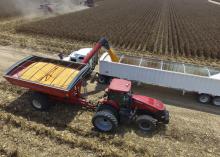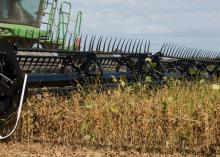Information Possibly Outdated
The information presented on this page was originally released on October 10, 2022. It may not be outdated, but please search our site for more current information. If you plan to quote or reference this information in a publication, please check with the Extension specialist or author before proceeding.
Crop harvest in Mississippi is going well, average yields
STARKVILLE, Miss. -- “Snow” appearing on the sides of highways and bare ground visible for miles is a sure indication that row crop harvest in Mississippi is well underway.
As of early October, the majority of the 2022 crop was already harvested, although much work remains for certain crops.
Will Maples, agricultural economist with the Mississippi State University Extension Service, said the price outlook for 2022 crops is shaping up to be good.
“Commodity prices across the board are higher than we have seen the last couple of years,” Maples said.
For each of the state’s major row crops, current prices are higher than 2021 prices and significantly higher than 2020 prices.
“Many market factors have contributed to the current market strength,” he said. “Cotton prices have been boosted from record abandonment of acreage due to drought conditions in west Texas. Lower planted acreage and yield outlook nationally is leading towards a short corn crop. The Ukraine/Russia War added volatility into the world markets early in the year, especially to the wheat and corn markets.”
Despite high prices, profits are tight because of increased production costs for the 2022 crop. Producers must market carefully with price goals set to take advantage of current high prices.
“High prices come with high price volatility in the market,” Maples said. “Producers considering holding any production for sale later in the crop year need to examine the risk management tools available to ensure they cover these higher production costs.”
Corn was the first row crop completed. Erick Larson, Extension grain crop agronomist, said a late planting for most of the state’s corn had the crop developing during the hottest part of summer.
“We had much hotter and drier weather during June and July than normal,” Larson said. “This took a toll on the corn crop, especially the dryland acres dependent upon natural rainfall. That reduced yield potential, bringing it to an expected state average of about 172 bushels an acre.”
Since 2017, Mississippi growers have harvested between 174 and 189 bushels an acre on average.
The U.S. Department of Agriculture estimated rice was 80% harvested by Oct. 2. Hunter Bowman, Extension rice specialist, said the crop had a good year and harvest has progressed well.
“Input prices, especially fertilizer, hurt the number of rice acres planted in Mississippi this year,” Bowman said. “On the positive side, with fewer acres planted in such a labor-intensive crop as rice, growers were able to focus more on the rice they did plant.”
The latest USDA report estimates state average rice yields will be 2 bushels per acre lower than in 2021, but Bowman said he remains optimistic that average yields will surpass that mark if favorable harvest weather continues.
Trent Irby, MSU Extension soybean specialist, said Mississippi soybean producers planted about 2.3 million acres of this crop in 2022 and had harvested just over half of it as of Oct. 2.
“All indications from what’s been harvested to this point are that we are looking at an average yield for the year,” Irby said. “Some fields have been good, while others have been disappointing. This is not surprising considering the heat of the summer and the lack of rainfall that many areas experienced.”
The state’s average soybean yield is 54 bushels an acre, a number that has been rising as producers have set and tied the record average yield several times in the last few years.
“The short-term forecast remains favorable for harvesting, so keeping the combines moving and storing the harvested soybean are top priority right now,” Irby said.
USDA estimates 31% of the peanut crop was harvested by Oct. 2. Brendan Zurweller, MSU Extension peanut specialist, predicts an average yield based on challenges during the growing season.
“The dry, hot weather in late June and July and waterlogged areas from recent heavy rainfall in central Mississippi slowed plant growth,” Zurweller said. “Insect and disease pressure was average and specific disease pressure was on a field-by-field basis.”
Cotton producers in Mississippi are deep into harvest, with the USDA estimating 28% of the crop harvested as of Oct. 2. There were about 490,000 acres of cotton planted in Mississippi in 2022.
Brian Pieralisi, Extension cotton specialist, said that, although cotton was off to a good start at planting, wet weather in August caused some boll damage lower in the canopy and delayed harvest a bit in places.
“Defoliation has been the biggest concern facing cotton producers due to the cool nighttime temperatures,” Pieralisi said. “Defoliation is taking longer, and defoliants do not work as well in cool temperatures.”
Cotton harvest began in the Delta around Clarksdale and Greenwood, but growers were still defoliating in many places. Cotton takes two weeks from defoliation until harvest can begin.
Today, cotton is most efficiently harvested with a baler picker than with a basket picker. A baler picker requires one operator and can harvest up to 100 acres a day.
Pieralisi said he is optimistic that the state’s average cotton yield will match or beat the 1,116 pounds picked per acre in 2021.
“The extremely hot, dry summer was our No. 1 limiting factor,” Pieralisi said. “Irrigated cotton did very well, but early-planted, dryland cotton suffered the most.”
Although it’s not a row crop, hay is important as it supports the state’s cattle industry.
Rocky Lemus, Extension forage specialist, said hay production declined this year due to weather and an increase in nitrogen and other fertilizer costs. Mississippi has about 610,000 acres in hay production, and these acres yield an average of 2.5 tons of hay per year, with the totals varying widely based on fertilization rates and forage species.
“Fertilizer prices can not only impact yields, but also nutritive value,” Lemus said. “Producers tend to concentrate on producing more biomass while compromising the nutritive value, or crude protein and energy, in the hay. That will increase the need for the supplementation of commodity feeds, making the cost of feeding more expensive.”
Those with extra hay may be able to sell some at higher prices than normal because of high hay demand in Texas and other states battling drought or wildfires.
“Now is the time for producers to take samples and determine an action plan for better nutrient management for next year,” Lemus said.
Find more information on Mississippi crops at and .











